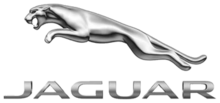 |
|
| Product type | Cars |
|---|---|
| Owner | Jaguar Land Rover |
| Produced by | Jaguar Land Rover |
| Country | United Kingdom |
| Introduced | 1936 |
| Related brands | Land Rover |
| Markets | Worldwide |
| Previous owners | Jaguar Cars |
| Website | www |
|
Former type
|
Private |
|---|---|
| Industry | Automotive |
| Fate | Merged with Land Rover to form Jaguar Land Rover |
| Predecessor | SS Cars Limited |
| Founded | 1934 |
| Founder | Sir William Lyons |
| Defunct | 31 December 2012 |
| Headquarters | Whitley, Coventry, United Kingdom |
| Website | www |
| Forums |
Jaguar is the luxury vehicle brand of Jaguar Land Rover, a British multinational car manufacturer with its headquarters in Whitley, Coventry, England, owned by the Indian company Tata Motors since 2008.
Jaguar's business was founded as the Swallow Sidecar Company in 1922, originally making motorcycle sidecars before developing bodies for passenger cars. Under the ownership of S. S. Cars Limited the business extended to complete cars made in association with Standard Motor Co, many bearing Jaguar as a model name. The company's name was changed from S. S. Cars to Jaguar Cars in 1945. A merger with the British Motor Corporation followed in 1966, the resulting enlarged company now being renamed as British Motor Holdings (BMH), which in 1968 merged with Leyland Motor Corporation and became British Leyland, itself to be nationalised in 1975.
Jaguar was de-merged from British Leyland and was listed on the London Stock Exchange in 1984, becoming a constituent of the FTSE 100 Index until it was acquired by Ford in 1990. Jaguar has, in recent years, manufactured cars for the British Prime Minister, the most recent delivery being an XJ in May 2010. The company also holds royal warrants from Queen Elizabeth II and Prince Charles.
Jaguar cars today are designed in Jaguar Land Rover's engineering centres at the Whitley plant in Coventry and at their Gaydon site in Warwickshire, and are assembled in their plants at Castle Bromwich and Solihull.
In September 2013 Jaguar Land Rover announced plans to open a 100 million GBP (160 million USD) research and development centre in the University of Warwick, Coventry to create a new generation of vehicle technologies. The carmaker said around 1,000 academics and engineers would work there and that construction would start in 2014.
History
Birth of the cars
The Swallow Sidecar Company was founded in 1922 by two motorcycle enthusiasts, William Lyons and William Walmsley. In 1934 Walmsley elected to sell-out and in order to buy the Swallow business (but not the company which was liquidated) Lyons formed S.S. Cars Limited finding new capital by issuing shares to the public.
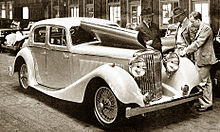

Jaguar first appeared in September 1935 as a model name on an SS 2½-litre sports saloon. A matching open two seater sports model with a 3½-litre engine was named SS Jaguar 100. |
On 23 March 1945 the S. S. Cars shareholders in general meeting agreed to change the company's name to Jaguar Cars Limited. Said Chairman William Lyons "Unlike S. S. the name Jaguar is distinctive and cannot be connected or confused with any similar foreign name."
Though five years of pent-up demand ensured plenty of buyers production was hampered by shortage of materials, particularly steel, issued to manufacturers until the 1950s by a central planning authority under strict government control. Jaguar sold Motor Panels, a pressed steel body manufacturing company bought in the late 1930s, to steel and components manufacturer Rubery Owen, and Jaguar bought from John Black's Standard Motor Company the plant where Standard built Jaguar's six-cylinder engines From this time Jaguar was entirely dependent for their bodies on external suppliers, in particular then independent Pressed Steel and in 1966 that carried them into BMC, BMH and British Leyland.
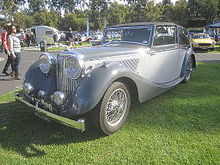
drophead coupé 1940
Jaguar made its name by producing a series of successful eye-catching sports cars, the Jaguar XK120 (1948–54), Jaguar XK140 (1954–57), Jaguar XK150 (1957–61), and Jaguar E-Type (1961-75), all embodying Lyons' mantra of "value for money". The sports cars were successful in international motorsport, a path followed in the 1950s to prove the engineering integrity of the company's products.
Jaguar's sales slogan for years was "Grace, Space, Pace", a mantra epitomised by the record sales achieved by the MK VII, IX, Mks I and II saloons and later the XJ6.[citation needed] During the time this slogan was used, but the exact text varied.
The core of Bill Lyons' success following WWII was the twin-cam straight six engine, conceived pre-war and realised while engineers at the Coventry plant were dividing their time between fire-watching and designing the new power plant. It had a hemispherical cross-flow cylinder head with valves inclined from the vertical; originally at 30 degrees (inlet) and 45 degrees (exhaust) and later standardised to 45 degrees for both inlet and exhaust.
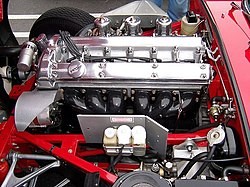 As fuel octane ratings were relatively low from 1948 onwards, three piston configuration were offered: domed (high octane), flat (medium octane), and dished (low octane).
As fuel octane ratings were relatively low from 1948 onwards, three piston configuration were offered: domed (high octane), flat (medium octane), and dished (low octane).
The main designer, William "Bill" Heynes, assisted by Walter "Wally" Hassan, was determined to develop the Twin OHC unit. Bill Lyons agreed over misgivings from Hassan. It was risky to take what had previously been considered a racing or low-volume and cantankerous engine needing constant fettling and apply it to reasonable volume production saloon cars.
The subsequent engine (in various versions) was the mainstay powerplant of Jaguar, used in the XK 120, Mk VII Saloon, Mk I and II Saloons and XK 140 and 150. It was also employed in the E Type, itself a development from the race winning and Le Mans conquering C and D Type Sports Racing cars refined as the short-lived XKSS, a road-legal D-Type.
Few engine types have demonstrated such ubiquity and longevity: Jaguar used the Twin OHC XK Engine, as it came to be known, in the Jaguar XJ6 saloon from 1969 through 1992, and employed in a J60 variant as the power plant in such diverse vehicles as the British Army's Combat Vehicle Reconnaissance (Tracked) family of vehicles, as well as the Fox armoured reconnaissance vehicle, the Ferret Scout Car, and the Stonefield four-wheel-drive all-terrain lorry. Properly maintained, the standard production XK Engine would achieve 200,000 miles of useful life.
Two of the proudest moments in Jaguar's long history in motor sport involved winning the Le Mans 24 hours race, firstly in 1951 and again in 1953. Victory at the 1955 Le Mans was overshadowed by it being the occasion of the worst motorsport accident in history. Later in the hands of the Scottish racing team Ecurie Ecosse two more wins were added in 1956 and 1957.
In spite of such a performance orientation, it was always Lyons' intention to build the business by producing world-class sporting saloons in larger numbers than the sports car market could support. Jaguar secured financial stability and a reputation for excellence with a series of elegantly styled luxury saloons that included the 3 litre and 3½ litre cars, the Mark VII, VIII, and IX, the compact Mark I and 2, and the XJ6 and XJ12. All were deemed very good values, with comfortable rides, good handling, high performance, and great style.
Combined with the trend-setting XK 120, XK 140, and XK 150 series of sports car, and nonpareil E-Type,[citation needed] Jaguar's elan as a prestige motorcar manufacturer had few rivals. The company's post-War achievements are remarkable, considering both the shortages that drove Britain (the Ministry of Supply still allocated raw materials) and the state of metallurgical development of the era.
In 1950, Jaguar agreed to lease from the Ministry of Supply the Daimler Shadow 2 factory in Browns Lane, Allesley, Coventry, which at the time was being used by The Daimler Company Limited and moved to the new site from Foleshill over the next 12 months. Jaguar purchased Daimler — not to be confused with Daimler-Benz or Daimler AG—in 1960 from BSA. From the late 1960s, Jaguar used the Daimler marque as a brand name for their most luxurious saloons.
An end to independence
Pressed Steel Company Limited made all Jaguar's (monocoque) bodies leaving provision and installation of the mechanicals to Jaguar. In mid-1965 British Motor Corporation (BMC), the Austin-Morris combine, bought Pressed Steel. Lyons became concerned about the future of Jaguar, partly because of the threat to ongoing supplies of bodies, and partly because of his age and lack of an heir. He therefore accepted BMC's offer to merge with Jaguar to form British Motor (Holdings) Limited. At a press conference on 11 July 1965 at the Great Eastern Hotel in London, Lyons and BMC Chairman George Harriman announced, "Jaguar Group of companies is to merge with The British Motor Corporation Ltd., as the first step towards the setting up of a joint holding company to be called British Motor (Holdings) Limited". In due course BMC changed its name to British Motor Holdings at the end of 1966.
BMH was pushed by the Government to merge with Leyland Motor Corporation Limited, manufacturer of Leyland bus and truck, Standard-Triumph and, since 1967, Rover vehicles. The result was British Leyland Motor Corporation, a new holding company which appeared in 1968, but the combination was not a success. A combination of poor decision making by the board along with the financial difficulties of, especially, the Austin-Morris division (previously BMC) led to the Ryder Report and to effective nationalisation in 1975.[citation needed]
Temporary return to independence
Over the next few years it became clear that because of the low regard for many of the group's products insufficient capital could be provided to develop and begin manufacture of new models, including Jaguars, particularly if Jaguar were to remain a part of the group.
In July 1984, Jaguar was floated off as a separate company on the stock market – one of the Thatcher government's many privatisations– to create its own track record.
Installed as chairman in 1980, Sir John Egan is credited for Jaguar's unprecedented prosperity immediately after privatisation. In early 1986 Egan reported he had tackled the main problems that were holding Jaguar back from selling more cars: quality control, lagging delivery schedules, poor productivity, and laid off about a third of the company's 10,000-some employees to cut costs. Commentators have since pointed out he exploited an elderly model range on which all development costs had been written off and raised prices as well as intensifying the push to improve Jaguar's quality but in the USA the price rises were masked by a favourable exchange rate.
Ford Motor Company era

Ford made offers to Jaguar's US and UK shareholders to buy their shares in November 1989; Jaguar's listing on the London Stock Exchange was removed on 28 February 1990. In 1999 it became part of Ford's new Premier Automotive Group along with Aston Martin, Volvo Cars and, from 2000, Land Rover. Under Ford's ownership, Jaguar never made a profit.
Under Ford's ownership Jaguar expanded its range of products with the launch of the S-Type in 1999 and X-type in 2001. After Land Rover's May 2000 purchase by Ford, it became closely associated with Jaguar. In many countries they shared a common sales and distribution network (including shared dealerships), and some models shared components, although the only shared production facility was Halewood Body & Assembly, for the X-Type and the Freelander 2. However operationally the two companies were effectively integrated under a common management structure within Ford's PAG.
On 11 June 2007, Ford announced that it planned to sell Jaguar, along with Land Rover and retained the services of Goldman Sachs, Morgan Stanley and HSBC to advise it on the deal. The sale was initially expected to be announced by September 2007, but was delayed until March 2008. Private equity firms such as Alchemy Partners of the UK, TPG Capital, Ripplewood Holdings (which hired former Ford Europe executive Sir Nick Scheele to head its bid), Cerberus Capital Management and One Equity Partners (owned by JP Morgan Chase and managed by former Ford executive Jacques Nasser) of the US, Tata Motors of India and a consortium comprising Mahindra and Mahindra (an automobile manufacturer from India) and Apollo Management all initially expressed interest in purchasing the marques from the Ford Motor Company.
Before the sale was announced, Anthony Bamford, chairman of British excavator manufacturer JCB had expressed interest in purchasing the company in August 2006, but backed out upon learning that the sale would also involve Land Rover, which he did not wish to buy. On Christmas Eve of 2007, Mahindra and Mahindra backed out of the race for both brands, citing complexities in the deal.
Tata Motors era
On 1 January 2008, Ford formally declared that Tata was the preferred bidder.Tata Motors also received endorsements from the Transport And General Worker's Union (TGWU)-Amicuscombine as well as from Ford. According to the rules of the auction process, this announcement would not automatically disqualify any other potential suitor. However, Ford (as well as representatives of Unite) would now be able to enter into detailed discussions with Tata concerning issues ranging from labour concerns (job security and pensions), technology (IT systems and engine production) and intellectual property, as well as the final sale price. Ford would also open its books for a more comprehensive due diligence by Tata. On 18 March 2008, Reuters reported that American bankers Citigroup and JP Morgan would finance the deal with a USD 3 billion loan.
On 26 March 2008, Ford announced that it had agreed to sell its Jaguar and Land Rover operations to Tata Motors of India, and that they expected to complete the sale by the end of the second quarter of 2008. Included in the deal were the rights to three other British brands, Jaguar's own Daimler, as well as two dormant brands Lanchester and Rover. On 2 June 2008, the sale to Tata was completed at a cost of £1.7 billion.
Assembly plant
The Swallow Sidecar company (SSC) was originally located in Blackpool but moved to Holbrook Lane, Coventry in 1928 when demand for the Austin Swallow became too great for the factory's capacity. In 1951, having outgrown the original Coventry site they moved to Browns Lane, which had been a wartime "shadow factory" run by The Daimler Company. Today, Jaguars are assembled at Castle Bromwich in Birmingham. The historic Browns Lane plant ceased trim and final operations in 2005, the X350 XJ having already moved to Castle Bromwich two years prior, leaving the XK and S-Type production to Castle Bromwich
In 2000, Ford turned its Halewood plant over to Jaguar following the discontinuation of its long running Escort that year for Jaguar's new X-Type model. It was later joined by the second-generation Land Rover Freelander 2, from 2007. Jaguars ceased being produced at Halewood in 2009 following the discontinuation of the X-Type; Halewood now becoming a Land Rover-only plant.
A reduced Browns Lane site operates today, producing veneers for Jaguar Land Rover and others, as well as some engineering facilities. A new assembly plant was opened at Pune, India in April 2011.
Jaguar will begin producing the Jaguar XE - the replacement for the X-Type - at Land Rover's Solihull plant in 2015, the first non-4x4 passenger car to be produced at the plant since the Rover SD1 in the late 1970s.
Current car models
F-Type

The F-Type convertible was launched at the 2012 Paris Motor Show, following its display at the Goodwood Festival of Speed in June 2012, and is billed as a successor to the legendary E-Type. In fact, the Series III E-Type already had a successor, in the form of the XJS, which was in turn replaced by the XK8 and XKR. The F-Type nevertheless returns to the 2-seat plan that was lost with the introduction of the Series III E-Type, which was available only in a 2+2-seat configuration. It was developed following the positive reaction to Jaguar's C-X16 concept car at the 2011 Frankfurt Auto Show. Sales will begin in 2013 with three engine choices; two variants of the AJ126 V6 petrol engine and the AJ133 V8 petrol engine.
XE

The XE is the first compact executive Jaguar since the 2009 model year X-Type and is the first of several Jaguar models to be built using Jaguar's new modular aluminium architecture, moving the company away from the Ford derived platforms that were used in the past for the X-Type and XF. The use of Jaguar's own platform allows the XE to feature either rear-wheel drive or all-wheel drive configurations, and it is the first car in its segment with an aluminium monocoque structure. Originally announced at the 2014 Geneva Motor Show with sales scheduled for 2015.
XF

The Jaguar XF is a mid-size executive car introduced in 2008 to replace the S-Type. In January 2008, the XF was awarded the What Car? 'Car of the Year' and 'Executive Car of the Year' awards. The XF was also awarded Car of the Year 2008 from What Diesel? magazine. Engines available in the XF are 2.2-litre I4 and 3.0-litre V6 diesel engines, or 3.0 litre V6 and 5.0-litre V8 petrol engines. The 5.0 Litre engine is available in supercharged form in the XFR. From 2011, the 2.2-litre diesel engine from the Land Rover Freelander was added to the range as part of a facelift.
XJ

The Jaguar XJ is a full-size luxury saloon. The model has been in production since 1968 with the first generation being the last Jaguar car to have creative input by the company's founder, Sir William Lyons. In early 2003, the third generation XJ arrived in showrooms and while the car's exterior and interior styling were traditional in appearance, the car was completely re-engineered. Its styling attracted much criticism from many motoring journalists who claimed that the car looked old-fashioned and barely more modern than its predecessor, many even citing that the 'Lyons line' had been lost in the translation from Mark 2 into Mark 3 XJ, even though beneath the shell lay a highly advanced aluminium construction that put the XJ very near the top of its class.
Jaguar responded to the criticism with the introduction of the fourth generation XJ, launched in 2009. Its exterior styling is a departure from previous XJs, with a more youthful, contemporary stance, following the design shift that came into effect previously with the company's XF and XK models.
The 5-litre V8 engine in the XJ Supersport can accelerate the car from 0 to 60 mph (0–97 km/h) in 4.7 seconds, and has a UK CO2 emission rating of 289 g/km. To cater to the limousine market, all XJ models are offered with a longer wheelbase (LWB) as an option, which increases the rear legroom.
R models
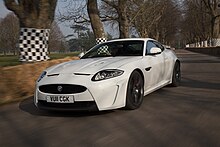
Jaguar began producing R models in 1995 with the introduction of the first XJR. Powered by a supercharged 6-cylinder engine, the car produced approximately 322 horsepower. With the revamped line of engines, the powerplant would be based on an eight-cylinder engine with supercharger from 1997 to present. The 1997–2003 XJR produced 370 horsepower (276 kW) and 385 pound-feet (522 N·m) of torque, taking the car to 60 mph (97 km/h) in 5 seconds. The new aluminium bodyshell from 2004 to 2009 and increased power to 400 hp (298 kW) and enhanced computer systems decreased the time to 60 mph (97 km/h) to 4.8 seconds. Starting after year 2000, XJRs were equipped with Jaguar's CATS (Computer Active Technology Suspension), which helped firm up the ride in sporty driving without compromising comfort during day-to-day use.
The first XKR was introduced in 1997 and kept with the same power increases as the XJR except for after 2006 the power in the XKR was boosted to 420 hp (313 kW). The S-Type R had a short production run from 2003 to 2008, and came equipped with the same 400 horsepower (298 kW) supercharged V8 as the other R models. It was replaced by the XFR, featuring a 5.0 L supercharged V8 producing 510 hp (380 kW).
- Jaguar XFR 510 hp (380 kW) mid-size saloon
- Jaguar XKR 510 hp (380 kW) coupé and cabriolet
- Jaguar XFR-S 550 hp (410 kW) mid-size saloon
- Jaguar XKR-S 550 hp (410 kW) coupé and cabriolet
- Jaguar XJR
- Jaguar F-Type R 550 hp (410 kW) coupé
Future models
After years of speculation, Jaguar designer Ian Callum confirmed in early 2012 that there would not be a Jaguar SUV, but suggested that he may be designing a crossover for Jaguar. In 2013 Jaguar announced the C-X17 concept, and in January 2015 announced the Jaguar F-Pace, due for a 2015 debut prior to going on sale in 2016. It will incorporate many cues from the C-X17 concept as the first-ever Jaguar crossover.
Previous models
Recent

The Jaguar S-Type, first appeared in 1999 and stopped production in 2008. It has now been replaced by the Jaguar XF. Early S-Types suffered from reliability problems but those were mostly resolved by the 2004 model year.
The Jaguar X-Type was a compact executive car launched in 2001, while the company was under Ford ownership. Sharing its platform with a 2000 Ford Mondeo, the X-Type ceased production in 2009.
The Jaguar XK is a luxury grand tourer introduced in 2006, where it replaced the XK8. The XK introduced an aluminium monocoque bodyshell, and was available both as a two-door coupé and two-door cabriolet/convertible. Production ceased in 2014.
Historic

The re-named Jaguar company started production with the pre-war 1.5, 2.5 and 3.5-litre models, which used engines designed by the Standard Motor Company. The 1.5-litre four-cylinder engine was still supplied by Standard but the two larger six-cylinder ones were made in house. These cars have become known unofficially as Mark IVs.
The first post-war model was the September 1948 Mark V available with either 2.5- or 3.5-litre engines. It had a slightly more streamlined appearance than pre-war models, but more important was the change to torsion bar independent front suspension and hydraulic brakes.[citation needed] In the spring of 1948 Lyons had returned from USA reporting Jaguar's individuality and perceived quality attracted the admiration of American buyers accustomed to the virtual uniformity of their home-grown vehicles.

The first big breakthrough was the launch in October 1948 of their new record-breaking engine design in their XK120 sportscar to replace the prewar SS Jaguar 100. It was powered by a new twin overhead camshaft (DOHC) 3.5-litre hemi-head six-cylinder engine designed by William Heynes, Walter Hassan and Claude Baily. The XK100 4-cylinder 2-Litre version had broken records in Belgium travelling at 177 mph. This XK engine had been designed at night during the war when they would be on fire watch in the factory. After several attempts a final design was achieved. That is until owner William Lyons said "make it quieter".
The sportscar bearing its prefix X had originally been intended as a short production model of about 200 vehicles. A test bed for the new engine until its intended home, the new Mark VII saloon, was ready.[citation needed]

The second big breakthrough was the large Mark VII saloon in 1950, a car especially conceived for the American market, Jaguar was overwhelmed with orders. The Mark VII and its successors gathered rave reviews from magazines such as Road & Track and The Motor. In 1956 a Mark VII won the prestigious Monte Carlo Rally. The XK120's exceptional reception was followed in 1954 by an improved XK140 then in May 1957 a fully revised XK150.

In 1955, the Two-point-four or 2.4 litre saloon (named by enthusiasts 2.4 Mark 1) was the first monocoque (unitary) car from Jaguar.[citation needed] Its 2.4-litre short-stroke version of the XK engine provided 100 mph (160 km/h) performance. In 1957, the 3.4-litre version with disk brakes, wire wheels and other options was introduced, with a top speed of 120 mph (190 km/h). In October 1959, an extensively revised version of the car with wider windows and 2.4, 3.4, and 3.8-litre engine options became the Mark 2. The 3.8 Mark 2 was popular with British police forces for its small size and 125 mph (201 km/h) performance.
The Mark VIII of 1956 and Mark IX of 1958 were essentially updates of the Mark VII, but the over-size Mark X of 1961 was a completely new design of large saloon with all round independent suspension and unitary construction.
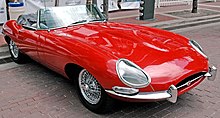
Jaguar launched the E-Type in 1961.
The independent rear suspension from the Mark X was incorporated in the 1963 S-Type, a Mark 2 lengthened to contain the complex rear suspension, and in 1967 the Mark 2 name was dropped when the small saloons became the 240/340 range. The 420 of 1966, also sold as the Daimler Sovereign, put a new front onto the S-type, although both cars continued in parallel until the S-Type was dropped in 1968. The slow-selling Mark X became the 420G in 1966 and was dropped at the end of the decade. Jaguar was saved by its new equally capacious but very much trimmer new XJ6.

Of the more recent saloons, the most significant is the XJ (1968–1992). From 1968 on, the Series I XJ saw minor changes, first in 1973 (to Series II), 1979 (Series III), a complete redesign for 1986/1987 in XJ40, further modifications in 1995 (X300), in 1997 with V8-power (X308), and a major advance in 2003 with an industry-first aluminium monocoque-chassis (X350). The most luxurious XJ models carried either the Vanden Plas (US) or Daimler (rest of world) nameplates. In 1972, the 12-cylinder engine was introduced in the XJ, while simultaneously being offered in the E Type.

1992 saw the introduction of the mid-engined, twin-turbo XJ220, powered by a 542 bhp (404 kW; 550 PS) V6 engine. The XJ220 was confirmed the fastest production car in the world at the time after Martin Brundle recorded a speed of 217 mph (349 km/h) on the Nardo track in Italy.
Over the years many Jaguar models have sported the famous chrome plated Leaping Jaguar, traditionally forming part of the radiator cap. Known as "The Leaper" this iconic mascot has been the subject of controversy in recent times when banned for safety reasons from cars supplied to Europe whilst it continued to be fitted on cars destined for the United States, Middle East and Far East. It has now been dropped from all the latest Jaguar models, although some customers add it to their car as a customization.
Complete line-up
Large executive
- 1935–1955 2½ Litre saloon
- 1937–1948 3½ Litre saloon
- 1948–1951 Mark V
- 1951–1957 Mark VII (& VIIM)
- 1957–1959 Mark VIII
- 1959–1961 Mark IX
- 1961–1966 Mark X
- 1966–1970 420G
- 1968–1987 XJ6 Series 1, 2 & 3
- 1972–1992 XJ12
- 1986–1994 XJ6 (XJ40)
- 1993–1994 XJ12 (XJ81)
- 1995–1997 XJ6 & XJ12 (X300 & X301)
- 1998–2003 XJ8 (X308)
- 2004–2007 XJ (X350)
- 2008-2009 XJ (X358)
- 2009–date XJ (X351)
Compact executive
- 1935–1949 1½ Litre saloon
- 1955–1959 Mark 1
- 1959–1967 Mark 2
- 1963–1968 S-type
- 1966–1968 420
- 1966–1968 240 & 340
- 1999–2008 S-type
- 2001–2009 X-type
- 2008–present XF
- 2015-present XE
Sports

- Jaguar XK120
- fastest production car in the world in 1949
- 1948–1954 XK120
- 1954–1957 XK140
- 1957–1961 XK150
- 1961–1974 E-Type
- 1975–1996 XJ-S
- 1992–1994 XJ220
- 1997–2006 XK8/XKR (X100)
- 2006–2014 XK (X150)
- 2013–present F-Type
- 2016(announced) F-Pace
Racing and competition
- 1950s C-Type
- 1950s D-Type
- 1960s E-Type Lightweight
- 1985–1992 XJR-5 through XJR-17
- 2009 XFR Bonneville Salt Flats speed record
- 2010 Jaguar RSR XKR GT2
Concept models
- E1A — The 1950s E-Type concept vehicle
- E2 A — The second E-Type concept vehicle, which raced at LeMans and in the USA
- Pirana (1967) — Designed by Bertone
- XJ13 (1966) — Built to race at LeMans, never run
- XK 180 (1998) — Roadster concept based on the XK8
- F-Type (2000) — Roadster, similar to the XK8 but smaller
- R-Coupé (2001) — Large four-seater coupé
- Fuore XF 10 (2003)
- R-D6 (2003) — Compact four-seat coupé
- XK-RR — A high-performance version of last generation XK coupé
- XK-RS — Another performance-spec version of last generation XK convertible
- Concept Eight (2004) — Super-luxury version of the long-wheelbase model of the XJ
- C-XF (2007) — Precursor to the production model XF saloon
- C-X75 (2010) — Hybrid-electric sports car, originally intended for production but cancelled in 2012
- C-X16 (2011) — Precursor to the production model F-Type
- C-X17 (2013) — First ever Jaguar SUV concept
- Project 7 — a 542 bhp V8-powered speedster based on the F-Type and inspired by the D-Type (2013)
Engines
Jaguar has designed in-house six generations of engines.
- Historical engines:
- XK6— Inline-6
- V12— 60° V12
- AJ6/AJ16— 22° Inline-6
- AJ-V6— 60° V6 (Ford designed, Jaguar modified)
- Current engines:
- AJ-V8— 90° V8
- AJ126— 90° V6
- AJD-V6— 60° V6 (Ford designed)
- Ingenium— Inline-4
Motorsport
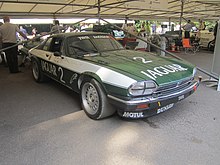
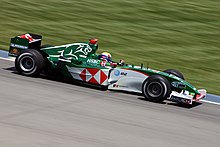
The company has had major success in sports car racing, particularly in the Le Mans 24 Hours. Victories came in 1951 and 1953 with the C-Type, then in 1955, 1956 and 1957 with the D-Type. The manager of the racing team during this period, Lofty England, later became CEO of Jaguar in the early 1970s. Although the prototype XJ13 was built in the mid-1960s it was never raced, and the famous race was then left for many years.
In 1982, a successful relationship with Tom Walkinshaw's TWR team commenced with the XJ-S competing in the European Touring Car Championship, which it won in 1984. In 1985, the TWR XJ-S won the Bathurst 1000 race. In the mid-1980s TWR started designing and preparing Jaguar V12-engined Group C cars for World Sports Prototype Championship races. The team started winning regularly from 1987, and won Le Mans in 1988 and 1990 with the XJR series sports cars. The Jaguar XJR-14 was the last of the XJRs to win, taking the 1991 World Sportscar Championship.
In the 1999, Ford decided that Jaguar would be the corporation's Formula One entry. Ford bought out the Milton Keynes-based Stewart Grand Prix team and rebranded it as Jaguar Racing for the 2000 season. The Jaguar F1 program was not a success however, achieving only two podium finishes in five seasons of competition between 2000 and 2004. At the end of 2004, with costs mounting and Ford's profits dwindling, the F1 team was seen as an unneeded expense and was sold to Red Bull energy drinks owner Dietrich Mateschitz, and it became Red Bull Racing.
On 15 December 2015, it was announced that Jaguar would return to motorsport by partaking in the third season of Formula E.
Notable Jaguar sports racers:
- Jaguar C-Type (1951–1953)
- Jaguar D-Type (1954–1957)
- Jaguar Lightweight E-Type
- Jaguar XJ13
- Jaguar XJR Sportscars
- Jaguar XJR-9 (1988)
- XJ220 (1988)
- XJR-15 (1990)
Electric vehicles
Lotus Cars joined Jaguar, MIRA Ltd and Caparo on a luxury hybrid executive sedan project called "Limo-Green"—funded by the UK Government Technology Strategy Board. The vehicle will be a series plug-in hybrid.
Facilities
Jaguar Land Rover operations are split between several sites, most of which are used for work on both the Jaguar and Land Rover brands.
Current plants
- Whitley Engineering Centre - Jaguar Land Rover's headquarters and a research and development centre. The older part of this plant was acquired from Peugeot in the 1980s, and was formerly a First World War airfield, an aircraft factory and then a missile factory before being sold to the Rootes Group (later Chrysler Europe).
- Gaydon Engineering Centre - Jaguar Land Rover's other research and development centre. Formerly an RAF bomber base before being acquired by British Leyland and redeveloped as a vehicle design, development and testing centre. Part of this site is also the Aston Martin headquarters, development centre and factory.
- Castle Bromwich - Jaguar Land Rover's main Jaguar assembly plant, producing the XF, XJ and F-Type ranges. Originally an aircraft factory during World War Two - Spitfires were built there, it was later acquired by Pressed Steel Fisher and became a vehicle body assembly works, it came under the auspices of Jaguar through the merger with BMC in the 1960s.
- Solihull - Jaguar Land Rover's principal Land Rover assembly plant. This was originally an aircraft engine plant during World War Two, being used for as a Rover plant after the war. In 2014 the Jaguar XE became the first Jaguar car to be assembled at the facility, followed by the Jaguar F-Pace in 2016.
- Halewood, Merseyside - Now used by Jaguar Land Rover for Land Rover production. Originally a Ford assembly plant (the Ford Escort being its most prolific model) it was given to Jaguar in 2000 for production of the X-Type. Ford still owns the transmission manufacturing operation at Halewood.
- Wolverhampton Engine Plant - a £500 million facility located at the i54 site in Staffordshire close to Wolverhampton where the Ingenium family of modular diesel and petrol engines are built. The plant was officially opened by Her Majesty Queen Elizabeth II on Thursday 30 October 2014.
Future plants
- Ryton-on-Dunsmore - Jaguar Land Rover announced that it will build a new Special Vehicle Operations development centre there in 2016. The site was previously used by Rootes for aircraft production plant for World War Two, and later became the Rootes/Chrysler/Peugeot car plant which was closed in 2006 and has since been completely demolished and the site cleared.
Past Jaguar plants
- Holbrooks Lane, Coventry - by the time Swallow Sidecar Company started using the Jaguar name, they had relocated from Blackpool to Holbrooks Lane in Coventry.
- Browns Lane - The most well-known site for Jaguar production from 1951, it was progressively run down and replaced by Castle Bromwich. Most of the plant has now been demolished and is now the home of Jaguar Land Rover's heritage centre.
- Radford - originally a Daimler bus plant but was later a Jaguar engine and axle plant. Closed by Ford in 1997 when it moved all Jaguar engine production to its Bridgend facility.
Jaguar and the arts

For some time now Jaguar has been active in the international arts scene. In particular, the company has collaborated with the artist Stefan Szczesny, implementing major art projects. In 2011, Jaguar presented the exhibition series "Shadows", which involved the installation of Szczesny's shadow sculptures in Sankt-Moritz, on Sylt and in Saint-Tropez. In 2012, a large number of sculptures, ceramics and paintings were shown in Frankfurt (and mainly in Frankfurt's Palmengarten).
As part of the collaboration with Szczesny, Jaguar has released the "Jaguar Art Collection".








